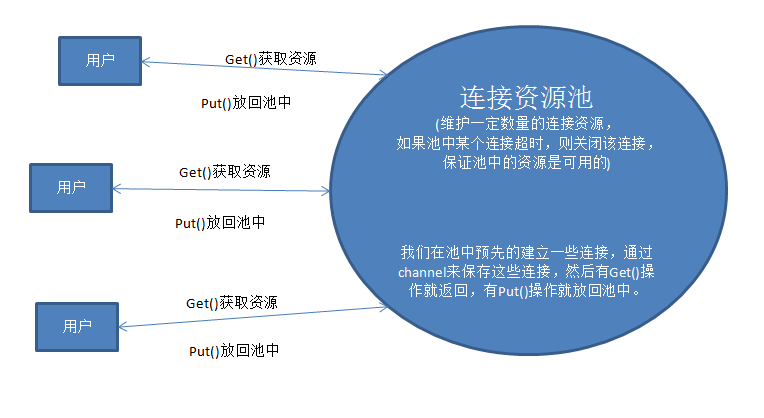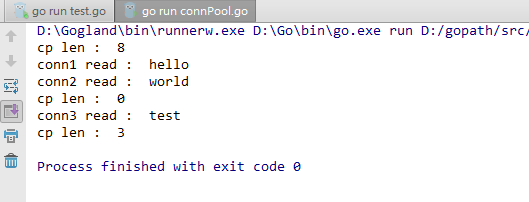一、连接池的描述图片如下:

二、连接池代码如下:
|
1
2
3
4
5
6
7
8
9
10
11
12
13
14
15
16
17
18
19
20
21
22
23
24
25
26
27
28
29
30
31
32
33
34
35
36
37
38
39
40
41
42
43
44
45
46
47
48
49
50
51
52
53
54
55
56
57
58
59
60
61
62
63
64
65
66
67
68
69
70
71
72
73
74
75
76
77
78
79
80
81
82
83
84
85
86
87
88
89
90
91
92
93
94
95
96
97
98
99
100
101
102
103
104
105
106
107
108
109
110
111
112
113
114
115
116
117
118
119
120
121
122
123
124
125
126
127
128
129
130
131
132
133
134
135
136
137
138
139
140
141
142
143
144
145
146
147
148
149
150
151
152
153
154
155
156
157
158
159
160
161
162
163
164
165
166
167
168
169
170
171
172
173
174
175
176
177
178
179
180
181
182
183
184
185
186
187
188
189
190
|
package main;import ( "time" "sync" "errors" "net" "fmt")//频繁的创建和关闭连接,对系统会造成很大负担//所以我们需要一个池子,里面事先创建好固定数量的连接资源,需要时就取,不需要就放回池中。//但是连接资源有一个特点,我们无法保证连接长时间会有效。//比如,网络原因,人为原因等都会导致连接失效。//所以我们设置一个超时时间,如果连接时间与当前时间相差超过超时时间,那么就关闭连接。//只要类型实现了ConnRes接口中的方法,就认为是一个连接资源类型type ConnRes interface { Close() error;}//工厂方法,用于创建连接资源type Factory func() (ConnRes, error)//连接type Conn struct { conn ConnRes; //连接时间 time time.Time;}//连接池type ConnPool struct { //互斥锁,保证资源安全 mu sync.Mutex; //通道,保存所有连接资源 conns chan *Conn; //工厂方法,创建连接资源 factory Factory; //判断池是否关闭 closed bool; //连接超时时间 connTimeOut time.Duration;}//创建一个连接资源池func NewConnPool(factory Factory, cap int, connTimeOut time.Duration) (*ConnPool, error) { if cap <= 0 { return nil, errors.New("cap不能小于0"); } if connTimeOut <= 0 { return nil, errors.New("connTimeOut不能小于0"); } cp := &ConnPool{ mu: sync.Mutex{}, conns: make(chan *Conn, cap), factory: factory, closed: false, connTimeOut: connTimeOut, }; for i := 0; i < cap; i++ { //通过工厂方法创建连接资源 connRes, err := cp.factory(); if err != nil { cp.Close(); return nil, errors.New("factory出错"); } //将连接资源插入通道中 cp.conns <- &Conn{conn: connRes, time: time.Now()}; } return cp, nil;}//获取连接资源func (cp *ConnPool) Get() (ConnRes, error) { if cp.closed { return nil, errors.New("连接池已关闭"); } for { select { //从通道中获取连接资源 case connRes, ok := <-cp.conns: { if !ok { return nil, errors.New("连接池已关闭"); } //判断连接中的时间,如果超时,则关闭 //继续获取 if time.Now().Sub(connRes.time) > cp.connTimeOut { connRes.conn.Close(); continue; } return connRes.conn, nil; } default: { //如果无法从通道中获取资源,则重新创建一个资源返回 connRes, err := cp.factory(); if err != nil { return nil, err; } return connRes, nil; } } }}//连接资源放回池中func (cp *ConnPool) Put(conn ConnRes) error { if cp.closed { return errors.New("连接池已关闭"); } select { //向通道中加入连接资源 case cp.conns <- &Conn{conn: conn, time: time.Now()}: { return nil; } default: { //如果无法加入,则关闭连接 conn.Close(); return errors.New("连接池已满"); } }}//关闭连接池func (cp *ConnPool) Close() { if cp.closed { return; } cp.mu.Lock(); cp.closed = true; //关闭通道 close(cp.conns); //循环关闭通道中的连接 for conn := range cp.conns { conn.conn.Close(); } cp.mu.Unlock();}//返回池中通道的长度func (cp *ConnPool) len() int { return len(cp.conns);}func main() { cp, _ := NewConnPool(func() (ConnRes, error) { return net.Dial("tcp", ":8080"); }, 10, time.Second*10); //获取资源 conn1, _ := cp.Get(); conn2, _ := cp.Get(); //这里连接池中资源大小为8 fmt.Println("cp len : ", cp.len()); conn1.(net.Conn).Write([]byte("hello")); conn2.(net.Conn).Write([]byte("world")); buf := make([]byte, 1024); n, _ := conn1.(net.Conn).Read(buf); fmt.Println("conn1 read : ", string(buf[:n])); n, _ = conn2.(net.Conn).Read(buf); fmt.Println("conn2 read : ", string(buf[:n])); //等待15秒 time.Sleep(time.Second * 15); //我们再从池中获取资源 conn3, _ := cp.Get(); //这里显示为0,因为池中的连接资源都超时了 fmt.Println("cp len : ", cp.len()); conn3.(net.Conn).Write([]byte("test")); n, _ = conn3.(net.Conn).Read(buf); fmt.Println("conn3 read : ", string(buf[:n])); //把三个连接资源放回池中 cp.Put(conn1); cp.Put(conn2); cp.Put(conn3); //这里显示为3 fmt.Println("cp len : ", cp.len()); cp.Close();} |
三、8080服务端代码如下:
|
1
2
3
4
5
6
7
8
9
10
11
12
13
14
15
16
17
18
19
20
21
22
23
24
25
26
27
28
|
package main;import ( "net" "io" "log")func handler(conn net.Conn) { for { io.Copy(conn, conn); }}func main() { lis, err := net.Listen("tcp", ":8080"); if err != nil { log.Fatal(err); } for { conn, err := lis.Accept(); if err != nil { continue; } go handler(conn); }} |
测试结果如下:

版权声明:博主文章,可以不经博主允许随意转载,随意修改,知识是用来传播的。